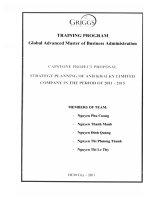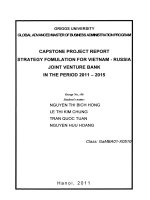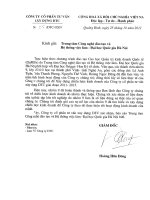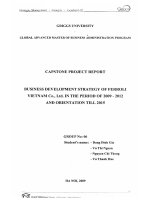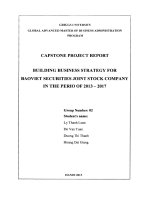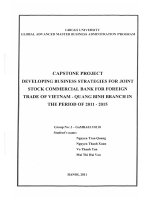Formulation of businessstrategy for embroidered products of minh trang limited company in the period 2011 – 2015
Bạn đang xem bản rút gọn của tài liệu. Xem và tải ngay bản đầy đủ của tài liệu tại đây (1.61 MB, 78 trang )
GRIGGS UNIVERSITY
GLOBAL ADVANCED MASTER OF BUSINESS ADMINISTRATION PROGRAM
CAPSTONE PROJECT REPORT
FORMULATION OF BUSINESS STRATEGY
FOR EMBROIDERED PRODUCTS
OF MINH TRANG LIMITED COMPANY
IN THE PERIOD 2011 – 2015
Group Number:
04
Student’s name:
Nguyen Thi Huyen
Ngo Ngoc Quang
Tran Kha Toan
Nguyen Tien Dung
Pham Ngoc Anh
HA NOI 2011
i
COMMITMENT
Group 04 - Class GaMBA01.X0409 pledges that the content of this Capstone
Project has not been submitted to any master degree program as well as any
training and diploma issuing program.
In addition, our Group also commits that this Project was the group‟s own efforts.
The results, analysis and conclusions in this Project (except for the quoted parts)
are the result of collective work of our group.
ii
ACKNOWLEDGEMENT
Group 04 - Class GaMBA01.X0409 sincerely thanks Dr. Tony Sanichara and
Assoc.Prof.Dr. Vu Thanh Hung who were very enthusiastic and dedicated to
deliver knowledge on the last subject of Master of Business Administration
Program - Strategic Management Course. The knowledge has helped group
members have a deeper understanding of this subject and through which the group
can complete the Capstone Project according to regulation of the program.
Our group also sincerely thanks teachers, faculty, board of directors of the
Program, student affair staff and all staff Gamba program – ETC, Vietnam
National University have provided a lot of other auxiliary knowledge and support
our group to complete this Project. The lectures and curriculum of the program
have helped many our group not only in studying but also in current operating our
enterprise.
In addition, our group also sincerely thanks leaders and staffs of Minh Co., Ltd.
have created favorable conditions in providing valuable comments, data and
practical knowledge for our group to carry out this Project.
In particular, the group would like to express our gratitude to family, colleagues
and friends who have created favorable condition for our group to have time for
this course. Sincerely thanks friends from class GaMBA01.X0409, over the past
year have always encouraged and supported us in studying process.
iii
TABLE OF CONTENT Trang
COMMITMENT i
ACKNOWLEDGEMENT ii
TABLE OF CONTENT iii
LIST OF SYMBOLS AND ABBREVIATIONS vi
LIST OF DIAGRAMS, TABLES AND FIGURES vii
INTRODUCTION
1. Name of the project 1
2. Rationale for selecting the project 1
3. Study purpose of the Capstone Project 2
4. Scope of the study 2
5. Methodology of the study 2
6. Meaning of the study 3
7. Structure of the Capstone Project 3
CHAPTER 1: THEORETICAL BASE OF BUSINESS STRATEGY AND
BUILDING BUSINESS STRATEGY
1.1. Business strategy concept 4
1.1.1. Strategy 4
1.1.2. Business strategy 4
1.1.3. Meaning of building business strategy 5
1.2. Process of building business strategy 6
1.2.1. Strategic vision, mission, and target of the enterprise 7
1.2.2. External environment analysis 10
1.2.2.1. Macro analysis (PEST model) 11
1.2.2.2. Micro analysis (Michael Porter‟ five forces model) 12
1.2.2.3. Analysis synthesis of external environment – EFE matrix 14
iv
1.2.3. Internal environment analysis 16
1.2.3.1. Enterprise‟s value chain analysis 16
1.2.3.2. Sustainable competitive advantage recognition process 17
1.2.4. SWOT matrix and selecting optimal strategy – SPQM matrix 17
1.2.4.1. SWOT Matrix 18
1.2.4.2. Optimal strategy selection 19
1.2.5. Competitive strategies 21
1.2.5.1. Cost leadership strategy 22
1.2.5.2. Differentiation strategy 23
1.2.5.3. Focus strategy 24
1.2.5.4. Common strategy integration 25
1.3. Summary of chapter I 26
CHAPTER 2: BUSINESS OPERATION SITUATION OF MINH TRANG
CO., LTD
2.1. Overview of the company 27
2.2. Vision and mission of Minh Trang Co., Ltd 30
2.3. External environment analysis 31
2.3.1. Macro analysis 31
2.3.2. Sectorial environment analysis 34
2.3.2.1. Overview of embroidered handicrafts market 34
2.3.2.2. Sectorial environment analysis applying five forces model 35
2.4. Internal environment analysis 42
2.4.1. Summary of operation situation and result from 2008 to 2010 42
2.4.1.1. Organizational structure 42
2.4.1.2. Human resource 43
2.4.1.3. Operation situation and result 45
2.4.2. Basic activities 51
2.4.3. Supporting activities 52
v
CHAPTER 3: PROPOSING STRATEGY AND SOLUTIONS FOR
SELECTED STRATEGY
3.1. Target of Minh Trang Co., Ltd 54
3.1.1. General target 54
3.1.2. Some main targets 55
3.2. Proposing and selecting optimal strategy 56
3.2.1. SWOT matrix and strategy proposal 56
3.2.2. Selecting strategy 58
3.3. Strategy implementing solution 59
3.3.1. Solution on products 59
3.3.2. Solution on market 61
3.3.3. Solution on finance 62
3.3.4. Solution on human resources 62
3.3.5. Solution on management 63
3.4. Plan to implement solutions 64
3.5. Recommendation 66
CONCLUSION 67
REFERENCES 69
vi
LIST OF SYMBOLS AND ABBREVIATIONS
1. Ltd: Limited
2. TCMN: Handicrafts
vii
LIST OF DIAGRAMS, TABLES AND FIGURES
No
Type
Name
Page
1.
Diagram 1.1
Business strategy building and selecting process
7
2.
Diagram 1.2
External environment factors
11
3.
Diagram 1.3
PEST model
12
4.
Diagram 1.4
Michael E.Porter „s Five forces model, 1980s
13
5.
Table 1.1
External factors evaluation matrix (EFE matrix)
15
6.
Diagram 1.5
Value chain model of Michael Porter
16
7.
Table 1.2
SWOT matrix
18
8.
Table 1.3
Strategic Planning Quantitative matrix with
GREAT criteria
19-20
9.
Table 1.4
Summary of suitable selections for each strategy
in basic competitive strategies
21-22
10.
Diagram 1.6
Advantage of low cost enterprise
23
11.
Diagram 2.1
Production process
30
12.
Chart 2.1
Rate of Vietnam craft villages
34
13.
Chart 2.2
Comparison in term of export turn over
35
14.
Table 2.1
National export revenue in three years from 2008
to 2010
38
15.
Table 2.2
Percentage rate of national export revenue in
three years from 2008 to 2010
38-39
16.
Table 2.3
Percentage rate of product groups export revenue
in three years from 2008 to 2010
40
17.
Table 2.4
Percentage rate of export major market share of
companies with similar products group in three
years from 2008 to 2010
40-41
18.
Diagram 2.2
Five Forces model of Embroidered sector
41
19.
Diagram 2.3
Organizational structure of the company
42
20.
Table 2.5
Human resource structure according to age and
gender
44
21.
Table 2.6
Labor qualification
44-45
viii
No
Type
Name
Page
22.
Table 2.7
Statistic of capital resource of the company in
three years from 2008 to 2010
45
23.
Table 2.8
Summary of balance sheet of the company
46-49
24.
Table 2.9
Business production result of the company from
2008 to 2010
49-50
25.
Table 3.1
Some major quotas of Minh Trang Co., Ltd in the
period 2011 - 2015
55-56
26.
Table 3.2
SWOT matrix analysis
58
27.
Table 3.3
Matrix selecting optimal strategy for Minh Trang
Co., Ltd
59
1
INTRODUCTION
1. Name of the project: Business strategy for embroidered products of Minh Trang
Co., Ltd in the period 2011 - 2015
2. Rationale for selecting the topic
Competition is one of market economy rules, is the way to live, exist and develop of
the enterprise. Through competition, products can be launched, more and more
perfect. This is also This is also selected environment for new entrepreneurs who
have stuff, dynamic, dare to think, dare to do, and adapt quickly to new
conditions. To be able to compete in market mechanism, building business strategy
for each enterprise is very important; it plays a crucial role in success of the
enterprise, towards enterprise to sustainable development in the market mechanism.
Business strategy enables managers and employees in all enterprises realize the
goals and direction of the business. Through which all members of the business will
know what to do and encourage them to get short-term achievements, while better
improve long-term interests of the business.
To be a limited company operating in producing and trading traditional handicrafts
products, Minh Trang Co., Ltd is not out of that general trend. In recent years, the
company has been trying to find itself long term development strategy so that its
products can always stand stably in the market. It can be seen that planning a
strategy for effective use of resources, exploitation of opportunities and limit risks is
critical task of Minh Trang Co., Ltd in current period. For this reason, Group 4 has
decided to select the topic "Formulation of Business strategy for embroidered
products of Minh Trang Co., Ltd in the period 2011 - 2015" to
study and complete the Capstone Project.
2
3. Study purpose of the Project
- Synthesize concepts, theoretical models related to building a business
strategy for enterprise
- Apply learned concepts and theoretical models in Strategic Management and
other subjects in building business strategy for Minh Trang Co., Ltd in the
period 2011 - 2015
- Select suitable business strategy to compete with other competitors in Ninh
Binh market
4. Scope of the study:
- This project only focuses on studying to build and select business strategy
for Minh Trang Co., Ltd in the period 2011 -2015.
- This project only researches on business operation of Minh Trang Co., Ltd
with specified product is embroidered product.
Study period:
- Situation: From 2008 to 2010
- Business strategy in the period 2011 - 2015
5. Methodology of the project
Methodology applied in this project are:
- Qualitative methodology, case study of Minh Trang Co., Ltd.
- Main data are statistic reports of the company, Ninh Binh handicrafts
association, information from newspaper, Internet, etc.
3
6. Meaning of the Project
- Basing on real situation of the enterprise, this project helps the owners,
managers have general view of current situation of the enterprise.
- Some given contents in the project can be reference for the enterprise to
orient long term business strategy and create foundation for the enterprise to
be active in developing embroidered handicrafts products business
orientation.
7. Structure of the Capstone Project
Besides the introduction and summary, the Capstone Project consists of 3 chapters,
including:
Chapter 1: Theoretical foundation on business strategy and building business
strategy.
Chapter 2: Business operation situation of Minh Trang Co., Ltd.
Chapter 3: Proposing strategy and strategy implementation solutions
4
CHAPTER 1:
THEORETICA FOUNDATION ON BUSINESS STRATEGY AND
BUILDING BUSINESS STRATEGY
1.1. Business strategy concept
1.1.1. Strategy
According to Prof. Alfred Chadler: Strategy is identification of basic and long term
targets of an enterprise, is description of necessary sources distribution and action
process to carry out those targets.
According to Prof. Kenneth L. Andrews: Strategy is model of targets, purposes and
plans to achieve those targets.
According to Prof. H. Igor Ansoff: Strategy is guideline for all activities of an
organization
1.1.2. Business strategy
According to Michael Porter: “Business strategy to compete with competition is the
combination of objectives need to achieve and means by which enterprises need to
find out to achieve goals”
Bruce Henderson – Strategic man as well as founder of Boston Consulting
Group said that two competitors can not coexist if their business practices are
identical, it is necessary to create new differences then they can exist and
competitive advantage is to put the company in a better position tan its rivals to
create economic value for customers.
5
Therefore, the nature of business strategy is to outline future image of the Enterprise
in the operating region and ability to exploit. In this sense, the term business
strategy is used by three most important aspects:
- Establishing long-term goals of the business based on competitive resources.
- Giving general action plan.
- Selecting the action plan, deploying resources distribution to implement that
goal.
1.1.3. Meaning of building strategy
Building business strategy is one of the most important activities of the enterprise
managers. An organization does not have a strategy like a ship has no rudder. Most
business failures are due to lack of a proper strategy, or lack of implementing right
strategy. Building business strategy to bring real benefits for enterprises:
- Define clearly goals in each period of the enterprise, help the enterprise to see
clearly business direction in the future to achieve the given goals.
- Help board of managers to see clearly external opportunities and threats, real
situation of strengths, weaknesses of the enterprise, predict changes in the
future to find out active solutions to deal with and adapt to new business
environment.
- Help the enterprise to explore and take use of its resources, bring into play
ultimately power of the enterprise to develop
- Help to distribute resources reasonably in each period, improve operating
efficiency of the enterprise.
- Help to increase cementation and commitment of staff and leaders in
implementing general goals of the enterprise.
6
- Help the business to increase labor productivity, increase sales and increase
effective management, avoid risks, increase prevention ability and prevent
difficult problems to the enterprise.
1.2. Business strategy building process
Business strategy has always been built on the basis of competitive advantage of the
enterprise in comparison with other competitors in each certain period
corresponding to specific business environment and internal conditions of the
enterprise. Business strategy of an enterprise is often built according to strategic
management process, which are building strategy stage, implementing strategy
stage and evaluating strategy stage. In particular, the period of "building strategy"
is the first stage, plays an important part and necessary condition to ensure
correctness and quality of remaining stages.
Building strategy methodically, adequate and feasible requires the enterprise to
identify its competitive advantages an weaknesses, in which competitive advantage
is defined as central priority for analyzing and building strategies. Competitive
advantage may be strategic vision of business leaders, business leadership, financial
capacity, human resources, technological know-how, relationship with partners,
client networks, input supply sources, the ability to adapt with changing
environment, …
Business strategy building process is described according to the following diagram:
7
Diagram 1.1: Business strategy selecting and building process
Source: Assoc.Prof.Dr Vu Thanh Hung – Lecture “Strategic management”
1.2.1. Strategic vision, mission, target of the enterprise
Mission of the enterprise
Defining vision, mission is first step in the process of business strategic planning, is
an essential first step, because it indicates destination in the future, what long-term
goals that the enterprise direct to, it is also the foundation to build policy, business
strategy for each period of the business.
Vision /
Mission of the enterprise
External environment
analysis
1. Macro environment
analysis: PEST model
2. Micro analysis: Five
forces model of
Michael Porter shows
competitive pressure
in the sector
Conclusion: we can see
opportunities and threats
for the enterprise.
Building and
selecting
strategy
- SWOT
model
- GREAT
optimal
selection
1. Low cost strategy
2. Differentiation strategy
- Characteristics
- Figures
- Customer services
3. Focus strategy
- Price
- Differentiation
Make the
organization
suitable to
selected strategy
Implement and
adjust selected
strategy
Verify and
evaluate the
results of
strategy
Infernal environment
analysis
Model
- Value chain
- Sustainable
competitive advantage
recognition process
Conclusion: we can see
strengths and weaknesses
in comparison with other
competitors
8
Mission of the enterprise: is the ability to feel deeply the whole major changes and
opportunities which can happen in the future for the enterprise. Foreseeing over the
current situation can help the enterprise to avoid threads, find out the most suitable
and best way, as well as take advantage of business development opportunities for it
own.
So what are factors of an effective enterprise vision? To be successful what the
enterprises need to do?
The enterprise needs to define 6 necessary factors of a vision, that are:
o Giving direction for the enterprise in the future
o Focusing on consumers benefit
o Practice
o Creating motivation
o It is essential to communicate fully
o Always following and assessing
And the barriers to the get vision and strategic plan? If the strategic plan and vision
are very important, so what are barriers to create them? In other words, what can
protect the enterprise to avoid mistakes in its vision and strategic plan namely:
o Awareness
o Enthusiasm
o Knowledge
o Ability to act
o Connection to business change or rebuild business process
Strategic targets for the enterprise
Strategic targets concept of the enterprise:
Strategic targets of the enterprise is ideal result that the enterprise has to achieve
within a certain period, in objective and subjective conditions of the enterprise in
9
accordance with given direction such as competitive position, business knowledge,
growth rate, etc.
Strategic targets of the enterprise need to be understood as qualitative norms. The
quantification of strategic targets has two benefits: the first one is easy to refer to
annual target, targets of each department, each factory, each team, and each person
with clear responsibility, the second one is easy to check. In the process of
implementation it can be based on quantitative norms to check whether the
enterprise has got it or not, if it detects any problem it can overcome, basing on
quantitative norms to encourage public efforts.
Content of strategic target of the enterprise:
Content of strategic targets of the enterprise includes 10 items:
- Profitability
- Competitive position in the market
- Productivity
- Product structure
- Finance target
- Building and developing the enterprise
- Invention
- Development of human resources
- Level of employee welfare
- Social responsibility of the enterprise
Strategic target system of the enterprise:
The general target of the enterprise is formed from targets of departments. They
base on their actual situation to build goal for each department. The enterprise will
10
synthesize to set common goal. Also, the enterprise will base on the general
situation to set common goals and divides into intermediate goals and specific
goals, discusses via organization from top down and vice versa to form a strategic
targets system of the enterprise.
In summary: The mission statement describes how an enterprise can combine
requirements of stakeholders (customers, suppliers, and its staff…) in making its
decisions and thereby reducing risks of losing the support from stakeholders;
And, the targets of the business can determine what to do if it wants to achieve the
mission. Well built targets must be accuracy, can measure, direct to key issues, must
be challenge but real, and must identify specific time to achieve.
1.2.2. External environment analysis
Environment of the whole national economy and sectorial environment are also
called external environment of the enterprise, which includes trends and events
beyond control of the enterprise so that enterprise must find ways to adapt to changes
of the environment. At certain level, the enterprise also can have opposite
effect and may alter its external environment. Analyzing and predicting trends of
factors of the external environment helps environment helps the enterprise see
opportunities and threats that it may face with. The fundamental factors of external
environment are shown in the diagram 1.2.
11
Diagram 1.2: External environment factors
Source: Assoc.Prof.Dr Nguyen, Lien Diep and MBA. Pham, Van Nam. 1998.
“Business strategy and policy”. Statistics publishing house
1.2.2.1. Macro analysis
To analyze macro environment, which is also known as the entire environment of
national economy, people use PEST theory including evaluation of political factors
(P), economic factors (E), social factors (S) and technological factors (T) to find out
the opportunities and threats for the enterprise operating in that business
environment.
Environment of the whole economy
Economic
factors
Political,
legal factors
Technological
factors
Social,
cultural
factors
Môi trường nội bộ ngành
Customers
Suppliers
Substitute
products
Potential
competitors
Existing
competitors
Enterprises
12
Diagram 1.3: PEST model
1.2.2.2. Micro analysis
To analyze sectorial environment, people use Michael Porter‟s five forces model.
This model mentions five forces that can bring about opportunities or threats for an
enterprise in one sector including (1) Supplier, (2) Current competitor, (3) Potential
competitors, (4) Customers, (5) Substitute products. Each force of these five forces is
affected by many other factors that these factors need to be researched more to create
full picture of competitiveness in one sector. The interaction of five forces creates
opportunities and threats for all enterprises in the sector. Thereby, this will help
enterprise to build competitive business strategy. This model is shown in diagram 1.4.
Source: Assoc.Prof.Dr Vu Thanh Hung – Lecture “Strategic management”
Politics
Stable politics
Labor law
Tax policy
Law system
Legal environment
Economics
GDP changes
Economic growing rate
Interest, inflation
Unemployment
Economy cycle
Society
Population, demography
National income distribution
Living style
People‟s knowledge, culture
Customs and habits
Technology
New technology discovery
Technology transfer
Government expenditures on
R&D
Technological products market
13
Diagram 1.4: Michael E.Porter’s Five forces model, 1980s
Competitiveness among existing enterprises
When mentioning the competition among existing enterprises, we must mention the
competition level of enterprises in the sector. The factors determine competitive
level of a sector, including growth rate of the sector, number of the enterprises and
their relative scale, height of barrier to draw from industry, products differentiation
of the enterprises and customer transfer costs:
Threats from newcomers
This threat is determined by "height of barriers to integrate". If the barriers to
integrate are high, threats from potential competitors reduce, the opportunity will
come to the enterprise. Decisive factors of the barriers to integrate include
economic scale, product differentiation and brand loyalty, distribution channels,
channels, absolute cost advantages.
Potential competitors
Suppliers
Current
competitors
Competition among
existing enterprises
Substitute products
Customers
Power of
suppliers
Power of
customers
Threats from new rivals
Threats from substitute goods
Source: Assoc.Prof.Dr Vu Thanh Hung – Lecture “Strategic management”
14
Power of customers
In relationship between enterprises and customers, if customers are “weak”, the
enternprises will have opportunity to increase prices to increase profits.
Conversely, the customers will be “stronger” than the enterprises. Specifically, if
costomers buy in bulk, if customers have more options to choose, when customers
are regular customers, when customers can supply materials for themselves with
lower-cost rather than purchasing outside …. the customers will have the power.
Power of suppliers
Suppliers capable can demand for increase price or reduce quality of supplied
products that means "stronger" than the enterprise. Specifically, the supplier will
be stronger in following cases: when the supplier have "no" many substitutes in
the market of industrial goods forcing the enterprise to choose them; when
business of the enterprise is not important for providers any more; when the
suppliers have advantages of supplied products specification making the enterprise
difficult to findout substitute products.
Threat from substitute products
According to Michael Porter, substitute products are the products of competitors in
different business sectors which have similar functionality to meet the same
consumption demand of customer. For example, in the coffee sector enterprises
indirectly compete with tea processing enterprises and other refresh soft drink
producers. If substitute products are produced on new technology lines with lower
price and better quality, this is a real threat to business. However, if the customers
have litter effort to substitute products and do not like to change the suppliers, this
threat will be reduced instead.
1.2.2.3 External environment analysis synthesis
15
After analyzing the opportunities and threats arising from the external environment,
strategists often use external factors evaluation matrix (EFE matrix) to summarize
and evaluate the impacts of those factors on the enterprise. Development process of
an EFE matrix consists of five steps:
1. Make a list of factors that play a decisive role for the success of the business.
2. Determine the importance from 0.0 (not important) to 1.0 (very important) for each
factor. Total classification levels are 1.0.
3. Classify from 1 to 4 for each factor to see how the current strategies of the
enterprise response to those factors, in which 4 is the best response, 3 is above
average response, 2 is average response and 1 is the least response.
4. Multiply importance of each factor with its classification to determine the total of
important points of each enterprise.
5. Cumulative plus the important points of factors to determine the total number
of critical points of each business.
Table 1.1: External factors evaluation matrix (EFE matrix)
Major external factors
Importance
Category
Important point
Total:
1.0
Source: Fred R. David. 2006. “Concepts of Strategic Management.
Statistics Publishing House – Page 180
Total highest important point that a business can achieve is 4.0 and the lowest one is
1.0. Total average important point is 2.5. Total of important points is 4 showing that
the enterprise is responding very well to the existing opportunities and threats in the
environment. In other words, the strategies of enterprise effectively utilize the
16
existing opportunities and minimize the threats of possible negative effects of
external threats. The total point is 1 indicating that the business strategy enterprise
set out does not take advantage of opportunities or avoid external opportunities.
1.2.3. Internal environment analysis
1.2.3.1. Enterprise value chain analysis
Analyze internal business environment to discover the strengths and weaknesses of
the enterprise to build suitable targets system and appropriate strategies to maximize
its strengths and can turn them into particular abilities, on the other hand, limit its
weaknesses. We analyze the internal business environment of the enterprise in term
of "value chain" analysis techniques of Michael Porter in diagram 1.5.
Diagram 1.5: Value chain model of Michael Porter
Supporting
activities
Infrastructure
Information System
Human Resource
Material management
Research and Develop (R&D)
Main
activities
Marketing
and sales
Production
After sales
service
Source: Assoc.Prof.Dr Vu Thanh Hung – Lecture “Strategic management”
The term value chain refers to the idea of considering a company as a sequence
of activities in transforming inputs into outputs which create value for customers.
The process of transforming inputs into outputs includes a number of main activities
and supportive activities. Each activity will add values to the product.
Value chain is divided into primary activities (functional activities) and other
supportive activities. The main activities of creating products, marketing and
Strategic
target


